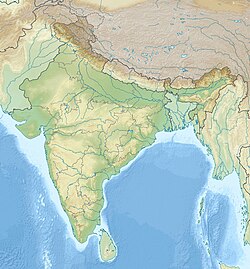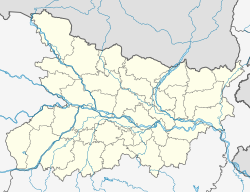Kesaria Stupa
| Kesariya Stupa | |
|---|---|
| Religion | |
| Affiliation | Buddhism |
| Sect | Theravada Buddhism |
| Status | Preserved |
| Location | |
| Location | |
| Administration | Archaeological Survey of India |
| Geographic coordinates | 26°20′03″N 84°51′17″E / 26.334140°N 84.854762°ECoordinates: 26°20′03″N 84°51′17″E / 26.334140°N 84.854762°E |
| Architecture | |
| Type | Stupa |
| Style | Buddhist |
| Height (max) | 32 metres (105 feet) |
| Materials | brick |
Kesariya stupa is a Buddhist stupa in Kesariya, located at a distance of 110 kilometres (68 mi) from Patna, in the Champaran (east) district of Bihar, India. The first construction of the Stupa is dated to the 3rd century BCE.[1] Kesariya Stupa has a circumference of almost 400 feet (120 m) and raises to a height of about 104 feet (32 m).[1]
History[edit]
The site's exploration reportedly started in the early 19th century, from its discovery led by Colonel Mackenzie in 1814 to General Cunningham's proper excavation in 1861–62. An excavation was conducted by archaeologist KK Muhammed of the Archaeological Survey of India (ASI) in 1998.[1] The original Kesariya stupa probably dates to the time of Ashoka (circa 250 BCE), as the remains of a capital of a Pillar of Ashoka were discovered there.[2]
The stupa mound may even have been inaugurated during the Buddha's time, as it corresponds in many respects to the description of the stupa erected by the Licchavis of Vaishali to house the alms bowl the Buddha has given them.The current stupa dates to the 200 AD and 750 AD[1] The ASI has declared the stupa a protected monument of national importance. Despite being a popular tourist attraction, Kesariya is yet to be developed and a large part of the stupa still remains under vegetation.[3]
Relationship with Borobodur[edit]
It has been noted that the Kesariya stupa shares many architectural similarities with the Buddhist temple located in Indonesia, Borobodur which points to a historical connections between east India and South East Asia. Both monuments share a circular mandala form with terraces containing figures of Buddha in the niches. Like Borobodur, Kesariya is also built atop of a hill. The excavated chambers at Kesariya show a combination of statues in bhumisparsha (of Akshobhya) and dhyanimudra (of Amitabha) on the same side, whereas Borobudur houses four Jina Buddhas, displaying their respective mudras on the four sides of the monument.[4]
Gallery[edit]
See also[edit]
| Pilgrimage to |
| Buddha's Holy Sites |
|---|
 |
| The Four Main Sites |
| Four Additional Sites |
| Other Sites |
| Later Sites |
References[edit]
- ↑ 1.0 1.1 1.2 1.3 Le Huu Phuoc, Buddhist Architecture, Grafikol 2009, pp.169-171
- ↑ Buddhist Architecture, Lee Huu Phuoc, Grafikol 2009, p.140-174
- ↑ "Kesaria Stupa – World's Tallest Buddhist Stupa". www.earthismysterious.com. Retrieved 18 May 2020.
- ↑ Chemburkar, Swati (2018). "Visualising the Buddhist Mandala: Kesariya, Borobudur, and Tabo". ndia and Southeast Asia: Cultural Discourses: 197–222.







